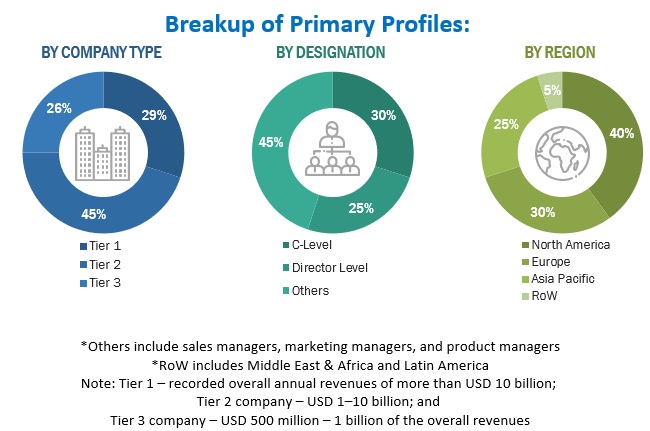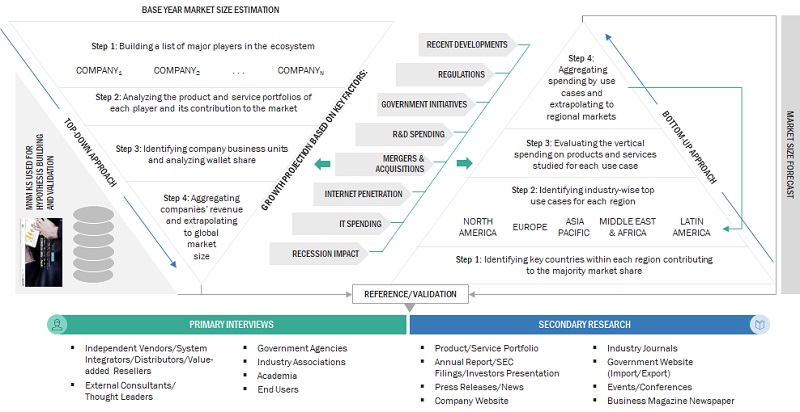The study involved four major activities in estimating the current market size of the Spatial computing market. We performed extensive secondary research to collect information on the market, the competitive market, and the parent market. The next step was to validate these findings, assumptions, and sizing with industry experts across the value chain through primary research. Both top-down and bottom-up approaches were employed to estimate the complete market size. After that, we used the market breakup and data triangulation procedures to estimate the market size of the various segments in the Spatial computing market.
Secondary Research
This research study used extensive secondary sources, directories, and databases, such as D&B Hoovers, DiscoverOrg, Factiva, vendor data sheets, product demos, Cloud Computing Association (CCA), Vendor Surveys, Asia Cloud Computing Association, and The Software Alliance. We referred to sources for identifying and collecting valuable information for this technical, market-oriented, and commercial study of the Spatial computing market.
Primary Research
Primary sources were several industry experts from the core and related industries, preferred software providers, hardware manufacturers, distributors, service providers, technology developers, alliances, and organizations related to all segments of the industry’s value chain. In-depth interviews were conducted with primary respondents, including key industry participants, subject-matter experts, C-level executives of key market players, and industry consultants, to obtain and verify critical qualitative and quantitative information and assess the market’s prospects.
We conducted primary interviews to gather insights, such as market statistics, the latest trends disrupting the market, new use cases implemented, data on revenue collected from products and services, market breakups, market size estimations, market forecasts, and data triangulation. Primary research also helped understand various technology trends, segmentation types, industry trends, and regions. Demand-side stakeholders, such as Chief Executive Officers (CEOs), Chief Information Officers (CIOs), Chief Technology Officers (CTOs), Vice Presidents (VPs), and Chief Security Officers (CSOs); the installation teams of governments/end users using asset performance management; and digital initiatives project teams, were interviewed to understand the buyer’s perspective on suppliers, products, service providers, and their current use of services, which would affect the overall Spatial computing market.

To know about the assumptions considered for the study, download the pdf brochure
Spatial Computing Market Size Estimation
We used top-down and bottom-up approaches to estimate and forecast the Spatial computing market and other dependent submarkets. The bottom-up procedure helped arrive at the overall market size using the revenues and offerings of key companies in the market. With data triangulation methods and validation through primary interviews, this study determined and confirmed the exact value of the overall parent market size. We used the overall market size in the top-down procedure to estimate the size of other individual markets via percentage splits of the market segments.
The bottom-up approach identified the trend of Spatial computing adoption among industry verticals in critical countries that contribute the most to the market. The adoption trend of asset performance management and varying cases of use concerning their business segments were identified and extrapolated for cross-validation. We gave weightage to the use cases identified in different solution areas for the calculation. We prepared an exhaustive list of all vendors offering Spatial computing in the market. We estimated the revenue contribution of all vendors in the market through annual reports, press releases, funding, investor presentations, paid databases, and primary interviews. We evaluated each vendor based on its service offerings across verticals. We extrapolated the aggregate of all companies’ revenue to reach the overall market size. Each subsegment was studied and analyzed for its market size and regional penetration. Based on these numbers, we determined the region split through primary and secondary sources.
The top-down approach prepared an exhaustive list of all vendors in the Spatial computing market. We estimated the revenue contribution of all vendors in the market through their annual reports, press releases, funding, investor presentations, paid databases, and primary interviews. We estimated the market size from revenues generated by vendors from different Spatial computing offerings. We identified other vendors and revenue generated from each service type with the help of secondary and primary sources and combined them to determine the market size. Further, the procedure included an analysis of the Spatial computing market’s regional penetration. With the data triangulation procedure and data validation through primaries, the exact values of the overall Spatial computing market size and its segments’ market size were determined and confirmed using the study. The primary procedure included extensive interviews for key insights from industry leaders, such as CEOs, CTOs, CIOs, VPs, directors, and marketing executives. We further triangulated market numbers with the existing MarketsandMarkets repository for validation.
Spatial computing Market: Top-Down and Bottom-Up approaches

To know about the assumptions considered for the study, Request for Free Sample Report
Data Triangulation
After arriving at the overall market size, the market was split into several segments and subsegments—using the market size estimation processes as explained above. To complete the overall market engineering process and arrive at the exact statistics of each market segment and subsegment, data triangulation and market breakup procedures were employed, wherever applicable. The data was triangulated by studying several factors and trends from the Spatial computing market’s demand and supply sides.
Market Definition
Considering the views of various sources and associations on spatial computing, MarketsandMarkets defines spatial computing as “a technology that blends the physical and digital worlds by integrating digital information and experiences into the physical environment. It encompasses a range of technologies and techniques, including augmented reality (AR), virtual reality (VR), mixed reality (MR), and various sensor technologies. In Spatial Computing, digital information and virtual objects are overlaid onto the real world, allowing users to interact with and manipulate them as if they were part of the physical environment. This technology often relies on devices such as head-mounted displays, smartphones, or smart glasses to provide users with immersive and interactive experiences.”
Key Stakeholders
-
Spatial Computing hardware and software providers
-
Augmented reality (AR), virtual reality (VR), and mixed reality (MR) device manufacturers
-
Professional service providers and consulting companies
-
Raw material suppliers
-
Semiconductor foundries
-
Original Equipment Manufacturers (OEM)
-
Government organizations, forums, alliances, and associations
-
System Integrators (SIs)
-
Value-added Resellers (VARs)
-
Research organizations
-
Technology standard organizations, forums, alliances, and associations
-
Technology investors
-
End-use verticals
Report Objectives
-
To define, describe, and forecast the global spatial computing market based on component, technology type, vertical, and region.
-
To forecast the market size of the five major regional segments: North America, Europe, Asia Pacific, Middle East & Africa, and Latin America
-
To strategically analyze the market subsegments with respect to individual growth trends, prospects, and contributions to the total market
-
To provide detailed information related to the major factors influencing the growth of the market (drivers, restraints, opportunities, and challenges)
-
To strategically analyze macro and micromarkets1 with respect to growth trends, prospects, and their contributions to the overall market
-
To analyze industry trends, patents and innovations, and pricing data related to the spatial computing market.
-
To analyze the opportunities in the market for stakeholders and provide details of the competitive landscape for major players.
-
To profile key players in the market and comprehensively analyze their market share/ranking and core competencies
-
To track and analyze competitive developments, such as mergers & acquisitions, product developments, and partnerships & collaborations in the market.
Note 1. Micromarkets are defined as the further segments and subsegments of the market included in the report.
Note 2. The companies’ Core competencies are captured in terms of their key developments and essential strategies to sustain their position in the market.
Available Customizations
With the given market data, MarketsandMarkets offers customizations per the company’s specific needs. The following customization options are available for the report:
Product Analysis
-
The product matrix provides a detailed comparison of the product portfolio of each company.
Geographic Analysis
-
Further breakup of the Asia Pacific market into countries contributing 75% to the regional market size
-
Further breakup of the North American market into countries contributing 75% to the regional market size
-
Further breakup of the Latin American market into countries contributing 75% to the regional market size
-
Further breakup of the Middle Eastern & African market into countries contributing 75% to the regional market size
-
Further breakup of the European market into countries contributing 75% to the regional market size
Company Information
-
Detailed analysis and profiling of additional market players (up to 5)



Growth opportunities and latent adjacency in Spatial Computing Market